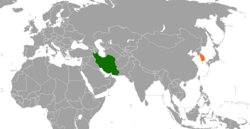Iran–South Korea relations
 |
|
|
Iran |
South Korea |
|---|---|
Iran and South Korea have had diplomatic relations since 1962. Throughout history, the two countries have maintained a strong, friendly and strategic partnership despite Iran's close relationship with North Korea, and South Korea's close relationship with the United States.
The big friendship between Korea and Iran is often referred as "Korea-Iran One Heart One Soul" (Persian: Korea–Iran yek-deli ; Korean: 한국 -이란 하나의 마음 하나의 영혼).
Korea's and Iran's long-running relationship started with cultural exchanges date back to the Three Kingdoms of Korea era, more than 1600 years ago by the way of the Silk Road. A dark blue glass found in the Cheonmachong Tomb, one of Silla's royal tombs unearthed in Gyeongju. An exotic golden sword found in Gyerim-ro, a street also located in Gyeongju. These are all relics that are presumed to be sent to Silla from ancient Iran or Persia through the Silk Road. It was only the Koryeo Dynasty during King HyeonJong's reign when trade with Persia was officially recorded in Korean history. But in academic circles, it is presumed that both countries had active cultural exchanges during the 7th century Silla era which means the relationship between Korea and Iran began more than 1500 years ago."If a history book written by the Persian scholar Khurdadbid, it states that Silla is located at the eastern end of China and reads 'In this beautiful country Silla, there is much gold, majestetic cities and hardworking people. Their culture is comparable with Persia'.
“We have a myth in an ancient Persian book (The Kushnameh) that tells of a Persian prince who went to Silla in the seventh century and got married with a Korean princess, thus forming a royal marriage.” Park Geun-hye said during a Festival celebrating Iran and Korea’s 1500’s years of shared cultural ties. She then said, “this is actually quite a good plot for making a film together.” Her suggestion was received with a lot of applause.
Other items uncovered during the excavation include a silver bowl engraved with an image of the Persian goddess Anahita; a golden dagger from Persia; clay busts; and figurines portraying Middle Eastern merchants. Samguk Sagi—the official chronicle of the Three Kingdoms era, compiled in 1145—contains further descriptions of commercial items sold by Middle Eastern merchants and widely used in Silla society. The influence of Persian culture was profoundly felt in other ways as well, most notably in the fields of music, visual arts, and literature. The popularity of Iranian designs in Korea can be seen in the widespread use of pearl-studded roundels and symmetrical, zoomorphic patterns. An ancient Persian epic poem, the Kushnameh, contains detailed descriptions of Silla.
...
Wikipedia
